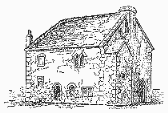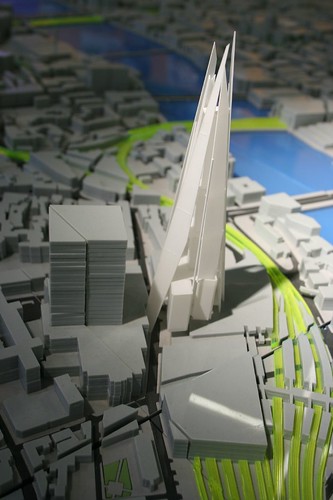Friday 12 June 2009
City of London Parish Churches link
English Parish Churches
English Parish Churches
There are few sights that evoke "Englishness" more than that of a slumbering parish church. Cathedrals in England span only about 400 years of English history and cultural influence (with the exception of a very few modern cathedra, which don't evoke much of anything).
 |
| Anglo-Saxon church, Sompting, Sussex |
Parish churches, on the other hand, tell the tale of some 1300 years of English history and social change. The humble parish church is an integral part of English social life and culture.
The oldest surviving parish churches in England date to about 670 AD (Brixworth and Escombe). At that time 3 distinct classes of churches were built; "cathedral" churches, "collegiate" churches, and local churches/private chapels built by individual Anglo-Saxon thegns (lords).
Cathedral churches were not cathedrals in the modern sense, but "mother churches" from which the first missionary priests went out to preach Christianity to the pagan inhabitants in a particular region.
Collegiate churches, also known as "old minsters" were daughter houses of the cathedral churches; a sort of second level regional missionary church.
Churches, or chapels (only later called "parish churches"), were generally private foundations, established by thegns, bishops, lay societies, or even an association of parishioners.
| The first parish churches were not built by the church, but by local lords. They were essentially owned and operated by that lord. |
Churches were often located on pre-Christian sites of spiritual significance, taking advantage of people's existing devotion to a particular place. Worship was carried on in the same place, just with a Christian orientation. Speaking of orientation, churches are nearly always oriented so that the main altar is at the east end of the church, facing Jerusalem, and, not coincidentally, the rising sun. Even if the altar end of the church is not literally in the east, it is called the "east end". In theory at least, the east end of an English parish church could face west!
The origin of the English parish is murky. The term originally meant an administrative district. When the term "parish" was first applied to the church, it meant the territory of a bishop, what we would today call a diocese.
It is speculated by historians that parish boundaries were originally those of Saxon manors. The extent to which the church parish and the local lord's authority overlapped is apparent when you consider that before the Norman invasion one of the accepted ways of becoming a thegn was to build a church, especially one with a tower (the tower was a defensive measure against the threat of Danish invaders).
The thegn could install a priest of his own choosing, change the priest at will, even dismantle the church if he saw fit!
The chancel of the church was the domain of the priest, and the nave "belonged" to the parishioners. Each was responsible for the upkeep of their domain. This helps explain the curious architecture of some early parish churches, particularly in Norfolk and Suffolk, where the chancel is built of carefully squared stone, and the nave of much cheaper flint.
| The basic architectural characteristics of the Saxon parish churches are: rectangular east end, side entrance (usually on the south side), and a west tower. |
The distinction between chancel and nave led to the development of rood screens to mark the division between the domain of the priest and that of his parishioners. These screens, usually of wood, but sometimes of stone, became extremely elaborate. Many were destroyed under the Reformation and the later Puritan influence. Only a few of the early screens remain, as at Stanton Harcourt (Oxon), and Bramfield (Suffolk).
One point to remember is that there was no seating in churches at that time. People attending a service stood in the nave. Luckily, it was not until much later that long sermons became popular (see below), so the parishioners did not have to suffer long!
 |
| Plan of Boarhunt (Hants) Saxon church |
The floor plan of southern Anglo-Saxon churches was based on the traditional Roman basilica, with an eastern apse, no transepts, western entrance, and aisles. Good examples survive at Brixworth (Northants), Wing (Bucks), and Worth (Sussex).
In the north the Celtic influence led to churches that were narrow, tall, and rectangular, with doors on the sides.
Curiously, despite the triumph of the Roman church over the Celtic one, it was the Celtic model that became the norm for parish churches in England. The Normans rebuilt many of the earlier Saxon churches, in the process destroying much of the regional differences in favour of a more unified Norman "look".
 |
| West Dean parsonage, 13th century |
Early Norman churches were aisless, with a central tower, and built to a cruciform plan (i.e., they were shaped like a cross, or like a small t).
Medieval parish churches were usually plastered inside and out. Vivid picture were painted on the interior plaster to illustrate Biblical scenes for the illiterate popluation. Statuary was also richly painted. Sadly, very little of the original plastering or painting remains today, so it requires a strong imagination to picture how the churches would have looked 1,000 years ago.
Before the Great Plague of 1348-50 the growing population necessitated more space inside parish churches, so many churches added aisles at this time.
The most notable parish churches of the late medieval period are the so called "wool churches" common to the Cotswolds and East Anglia. These are churches endowed by the newly rich class of local merchants thriving on England's wool trade.
Many of these magnificent buildings, such as Thirsk (Yorkshire), Northleach (Gloucestershire), and Lavenham (Suffolk), are like mini-cathedrals, complete with fanciful carvings, elaborate ornamentation and funereal monuments inside the church.
The Tudor era saw one important change; it was under the influence of Elizabeth I that preaching long sermons became popular. And by long, I mean loonnnnng - 2 to 4 hours was not uncommon. This meant that the victims, ... er ...church attendees, needed to sit to listen, so pews became standard in the naves. The preacher needed a lectern, and more often, a pulpit. So the pulpit was added to the nave also. Most of the pulpits you see in parish churches today date from the Tudor period, or later.
The Tudor period saw the end of the great church-building era. Far fewer churches were built from this point to the present day, the most prominent (architecturally speaking) being the Classical motif of the Stuart and Georgian period, and the Gothick Revival of mid-Victorian times.
Most new parish churches were built in the ever-growing cities, where the expanding urban population necessitated new parishes. Most notable here is London, where the Great Fire of 1666 destroyed most of the medieval churches (and gave a young architect named Christopher Wren quite an opportunity to evolve a new classical style of church).
In the modern era there is more religious freedom, and with the subsequent splintering of Christian sects, and the introduction of more non-Christian religions into England there are few new parish churches built. And those that are may be interesting to their parishioners but to few others. Some of the old churches that once served prosperous villages have fallen into disuse and been abandoned as population shifted. Many of these churches are now being looked after by the Redundant Churches Fund.
Most parish churches are open to visitors. Just walk in (and dress warmly if you plan to do this a lot - they can be chilly even on the warmest days). Many churches have placards or handouts giving details of the building history and pointing out its architectural features. These small gems of living history give a much better sense of England and its culture than do the grandest cathedrals, and they're usually free. Just drop some small change in the donation box by the door.
Tuesday 9 June 2009
Scrapbook Presentation
James Biber’s

James Biber filled a Moleskine notebook with a year’s worth of images and sketches.
Last winter James Biber was invited by I.D. Magazine to fill a Moleskine sketchbook for A Week in Your Life - 13 Book d’Autore, an exhibition of notebooks from 13 architects, designers and writers. Originally on view in Milan for 2009 International Design Week, the exhibition has now reached the Art Directors Club in New York, where, following a one night viewing for last week’s Stationery Show, it will be exhibited this Friday, May 29 for a viewing timed to Book Expo America.
Each participant in the exhibition was sent a notebook from Moleskine’s new Folio Collection and asked to document a week in their lives. For his book, Biber took the opportunity to go further. “During the last week of the year I collected the previous 12 months in an album of collage, images and sketches,” he says.
“Digital images, though convenient and easy to manage, are inherently non-tactile, can’t be juxtaposed or drawn on, and sit too neatly in the software’s grid. The Moleskine, and some transfer film, allowed me to create composites, contrasts and collages of a year’s worth of travel and projects. It’s the one chance to do what we all used to do with pictures: sort them, pile them up, throw them on a table and see them as objects rather than digital files.
“I plan to make it a yearly ritual. Finally, I am a part of the scrapbooking movement. Next, decoupage.”
Other participants in the exhibition include Yves Béhar, Marian Bantjes, Ayse Birsel, Han Feng, Michael Graves and Jessica Helfand. Friday night’s viewing runs from 6:30 to 9:30 pm and is open to the public. At the Art Directors Club, 106 West 29th Street in New York City.
Alan Fletcher
Fletcher was one of the five founders of the famous London design house, Pentagram. His love of his craft seems to shine through in all his work, even the larger client work he did for Fortune Magazine, Reuters, Herman Miller and Pirelli. As he said himself,
I’d sooner do the same
on Monday or Wednesday
as I do on a Saturday or Sunday.
I don’t divide my life between labour and pleasure.
Having studied at the Royal College of Art in the 1950s and then Yale, he was foremost a painter and artist. This shows in all his work, which is less about grid like simplicity, which was so much apart of the 60s and 70s, but an organic style that was unique to him.
Monday 8 June 2009
More comment on London Bridge project
The Space between platforms, bridge between platforms
The Waking, Theodore Roethke, 1953
I feel my fate in what I cannot fear.
I learn by going where I have to go.
We think by feeling. What is there to know?
I hear my being dance from ear to ear.
I wake to sleep, and take my waking slow.
The Waking, Theodore Roethke, 1953
Thursday 4 June 2009
The Shards, New London Bridge Station
The Shards,
New London Bridge Station
By Renzo Piano
Shard London Bridge,
also known as London Bridge Tower, the Shard of Glass, 32 London Bridge and The Shardsupertall skyscraper under construction in Southwark, London. When completed in 2012 it will be the tallest building in the United Kingdom and one of the tallest buildings in Europe.
Design&Planning
It would replace Southwark Towers, a 24-storey office building which was completed in 1976. The tower would stand at 310 m (1,017 ft) tall and have 72 floors, plus 15 further radiator floorsBroadway Malyan during the planning stage of the project. After a lengthy public inquiry, the collaboration successfully achieved its objective, and the developers were granted full planning permission in November 2003. in the roof, making it the tallest building in the country. Renzo Piano, the building's architect, worked together with architectural firm
The Shard was announced with the hope that it would be the tallest building in Europe on completion, surpassing Frankfurt's Commerzbank Tower, which at 259 m (850 ft) had been the tallest building in Europe since 1997. The Commerzbank has since been surpassed in height by two Moscow skyscrapers, Triumph-Palace and Naberezhnaya Tower, both of which the Shard tower would, in turn, surpass. However, since 2000, construction has started on three skyscrapers in Moscow that will rise higher than the Shard tower, including the 612 m (2,008 ft) Russia Tower that is now on hold. Even though the Russia Tower is on hold the other two, the Federation Tower East and the Mercury City Tower are still scheduled to be completed before the shard. Still, if completed on schedule, the Shard London Bridge may become the tallest building in the European Union.
Another London skyscraper, the Bishopsgate Tower, was submitted for planning permission in London and was originally proposed to exceed the height by one metre. However, the scheduled height of the Bishopsgate Tower has now been reduced, so Shard London Bridge could once again become London's tallest occupied building if construction goes ahead. By way of comparison, Britain's tallest free-standing structure is the Emley Moor tower at 330.4 m (1,084 ft), and the tallest man-made structure of any kind in Britain (and the EU) is the Belmont mast at 385 m (1,260 ft).
Renzo Piano, the project's architect, has compared his design to "a shard of glass" – he considers the slender, spire-like form of the tower a positive addition to the London skyline and believes that its presence will be far more delicate than opponents of the scheme allege. He proposes a sophisticated use of glazing, with expressive facades of angled panes intended to reflect light and the changing patterns of the sky, so that the form of the building will change according to the weather and seasons.[citation needed][1]
In addition to the tower, there would be major improvements to London Bridge station and the surrounding area. As part of a Section 106 legal agreement, these would include a new concourse and public piazza, affordable housing and regeneration programmes.[2] A new museum would also be built.
A hotel, to be operated by Shangri-La Hotels and Resorts as their first European location, would be expected to take up around a fifth of the available space in the tower. A large pre-let for office space in the tower has been agreed in principle by Transport for London.
Data derived from the World Trade Center (WTC)collapse has resulted in a re-evaluation of the design of tall structures now being built globally. Shard’s early conceptual designs were among the first in the UK to be progressed following the publication of the US National Institute of Standards and Technology (NIST) report into the WTC collapse. The building will be designed to maintain its stability under the most onerous conditions.[3]
Another notable feature of the building would be a public viewing gallery at the top. This would be expected to draw over two million visitors a year. In addition, a shorter building known as London Bridge Place will be built nearby. This will replace the current London Bridge House and the combined sites will create what will be known as The London Bridge Quarter.
Construction
In February 2009, a mobile crane and a small piling rig appeared on site. In early March the small crane began putting steel beams into the ground, as part of preparations for the core of the building.
Full construction began on 16th March 2009, with the first piling rig on site.
The concrete core is expected to begin rising towards the end of the year, and completion is planned for May 2012.
Proposal
 Main concourse
Main concourse Apartment on the top
Apartment on the top Model
Model Construction Plan
Construction Plan The shard's Bird eye's view
The shard's Bird eye's viewMore details: http://www.shardlondonbridge.com/
London Bridge station Layout Change
Improvement&
Layout Change


Several initiatives will make life easier for passengers. The Thameslink Programme will deliver more trains, new direct journey opportunities and longer trains across the Thameslink route. This will allow more people to access London Bridge and help the area's growth.
Network Rail will improve the old Victorian track layout around the station, constructing a new two track viaduct will be over Borough Market, easing congestion and enabling more trains to travel north-south through London during peak times. The market below will continue as usual when work begins in 2009 with a number of stalls being moved to the newly covered Jubilee Market area on the northern side of the viaduct. Commuters will notice some immediate changes to the station layout as work on the Shard London Bridge picks up pace. Consessions such as Boots have already made way for construction to the south of the main concourse, while others retail units will be removed by May 2009 to increase the number of gates to platforms and improve passenger access. This work is financed by the Sellar Property Group as part of their collaboration with Network Rail to minimalise effects of construction on commuters. In the station itself works are extensive. A completely new, modern station and track layout are planned planned. This will be delivered in phases, keeping the station operational throughout construction. The works will remove key bottlenecks, increase the number of through platforms, improve passenger facilities, and significantly increase passenger capacity at the station.
The track layout work will begin after the Olympics, and is planned to be completed by the end of 2015. However, Network Rail will be looking to deliver any quick wins that we can for passengers, and work may well start before the Olympics to upgrade station facilities.
Wednesday 3 June 2009
Example of Thesis
http://www.arch.mcgill.ca/prof/mellin/arch671/winter2004/student/Altman/assign1.html
London Bridge Station, UK Comment & Reflection
Station, UK
Comment
- Need 1:50 floor plan to articulate the design
- 1:50 Space section of London Bridge concourse and the inserted structure
- Typical section and details plus material selection
Mission
Study more:
About human scale+furniture
Read more:
From place to non place







































